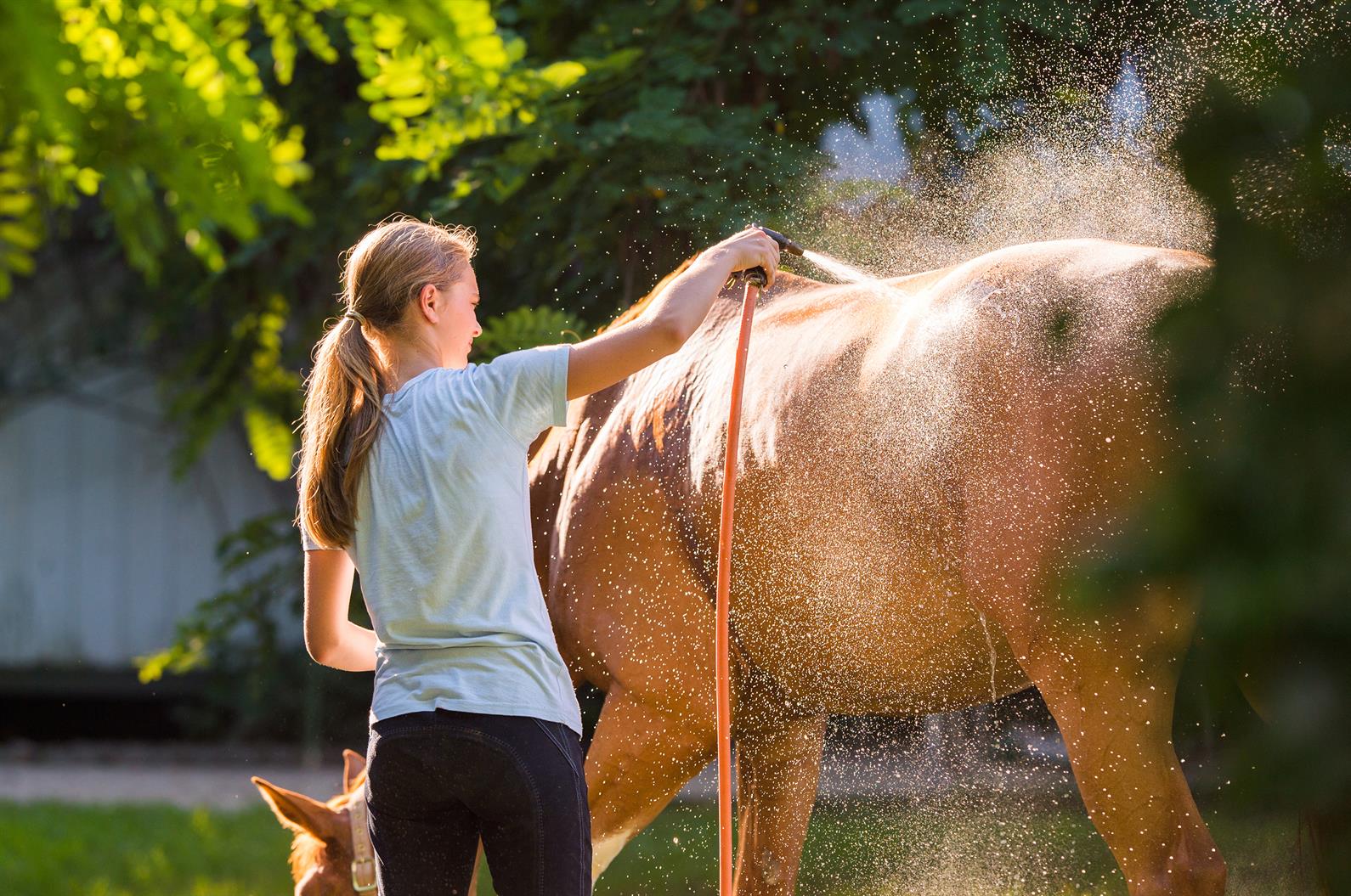Summer’s sultry weather can be more than uncomfortable for your horse or pony; it can be dangerous. It’s important to know the symptoms of heat stress and how to respond to them.

Horses that don’t sweat enough or who are engaged in a lot of physical exertion—like three-day eventers, polo ponies, or horses in sports that involve a fair amount of galloping—are most obviously at risk of overheating in hot, humid conditions, says Dr. Laura Werner, a surgeon at Hagyard Equine Medical Institute in Lexington, Ky. Werner specializes in equine emergency services and also has worked as a Fédération Equestre Internationale Veterinary Delegate at three-day eventing competitions in the United States.
But your horse or pony doesn’t have to be an Olympic-level competitor to be at risk in summer conditions, Werner notes.
“Horses can get overheated if both heat and humidity are high, and with the physical exertion that we ask them to do, that can happen pretty easily, just as it does with people,” said Werner. “Certainly, if the heat is in the high 80s and the humidity is about the same, it’s pretty easy for horses to get overheated quickly.”
Things to Consider
One thing to consider is whether the animal is accustomed to the particular climate.
“Some horses are more acclimated to warmer temperatures or higher humidity than others,” explained Werner. “Horses that are imported from Europe, for example, might not be used to heat and high humidity straight away. Just like with a person, it might take them a little bit to acclimate.”
It’s also helpful to remember that your horse generally is warmer than you are. So, if you’re hot, your horse is probably hotter, especially if he or she is working.
“When we’re asking them to perform, they’re doing a lot more work than we are!” Werner said.
Symptoms to Know
- High rectal temperature. The normal equine temperature is generally around 101 degrees Fahrenheit. Physical exertion in hot conditions can make that higher, but a temperature above 104 or so after a normal workout can signal a problem, especially if paired with other symptoms.
- Vocalizing. A horse in distress will sometimes whinny frequently.
- Lethargic, sluggish, or struggling to perform.
- Open-mouth breathing.
- High respiratory rate.
- Not sweating.
What to do
“The first thing to do is to get off your horse or stop working and walk them,” Werner said. “Try to cool them off with cool water. Get the tack off the horse very quickly. Head for a shady area.”
Some horses might require intravenous fluids, but many will respond to a cool bath, some water to drink, and a shady spot or fan.
Electrolyte therapy can also help a horse that has been performing in hot, humid conditions. “We do see some horses having electrolyte imbalances at this time of year because they’re losing so much through their sweat, and horses with electrolyte imbalances can even go on to develop thumps,” Werner said. Thumps, a hiccup-like thumping noise formally known as “synchronous diaphragmatic flutter,” can indicate issues like electrolyte imbalance, dehydration, or low calcium levels.
“If horses are actively working at a normal to moderate or heavy level of work, sometimes it is good to supplement their electrolytes at this time of year, because they are losing so much in their sweat,” Werner said. “Ideally, that can help ahead of time. If you have an event coming up that involves travel and/or physical activity, you can support them with an electrolyte paste to make sure they’re getting enough and their electrolyte supply isn’t depleted.”
Water on, Water off
The best and fastest way to cool a horse is to concentrate cool water on the big muscle groups, says Werner. That means spraying over the rump, back, flanks, chest, and shoulders.
“You want to get cold or ice-water on, and then scrape it right off,” Werner explained, “because otherwise, as the water warms up, it acts as an insulator and can help make them overheat.”
Some people will also put ice around key points, like the jugular, but, in many cases, the “water on, water off” routine will suffice, said Werner.
In the summer, do what you can to avoid exercising your horse during hot, humid conditions. “Try to ride during the cooler times of day if you can,” said Werner. “Whatever you’re feeling is what your horse is feeling, too. Take frequent breaks. And if it’s too hot and you don’t need to ride, don’t ride. If you do ride, try to stick to shady areas or take your horse for a hack instead of working in the hot arena. Just use your judgment: if it’s too hot for you, it’s probably too hot for your horse, too.”
Want articles like this delivered to your inbox every week? Sign up to receive the Equestrian Weekly newsletter here.
This article is original content produced by US Equestrian and may only be shared via social media. It is not to be repurposed or used on any other website than USequestrian.org.


